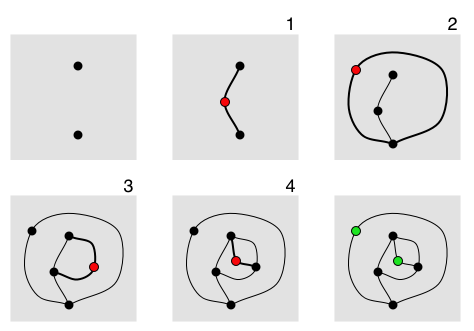CLASS EXERCISE #1 SPROUTS
Applying the Concepts of Game Structures
Adapted from Game Design Workshop by Tracy Fullerton
NOTE: Sprouts is an impartial paper-and-pencil game which can be analyzed for its mathematical properties. It was invented by mathematicians John Horton Conway and Michael S. Paterson at Cambridge University in the early 1960s. The setup is even simpler than the popular dots and boxes game, but gameplay develops much more artistically and organically.
The Game
For this exercise, you will need a piece of paper, two pens, and two players. First, take a moment to study the rules:
- Draw three dots randomly on the paper. Choose a player to go first.
- The first player draws a line from one dot to another dot.
- Then that player draws a new dot anywhere on that line.
- The second player also draws a line and a dot:
- The new line must go from one dot to another, but no dot can have more than three lines coming out of it.
- Also, the new line cannot cross any other line.
- The new dot must be placed on the new line.
- A line can go from a dot back to the same dot as long as it doesn't break the "no more than three lines" rule.
- The players take turns until one player cannot make a move. The last player to move is the winner.

Select a partner in the class and start playing! Do at least 5 rounds.
Concepts of Game Structure
Identify the formal elements of this game and write down your answers as a team in this markdown template:
Players:
- How many?
- Any requirements?
- Special knowledge, roles, etc.?
Objective:
- What is the objective of the game?
Procedures:
- What are the required actions for play?
Rules:
- Any limits on player actions?
- Rules regarding behavior? What are they?
- What are the rules?
Conflict:
- What causes conflict in this game?
Boundaries:
- What are the boundaries of the game?
- Are they physical? Conceptual?
Outcomes:
- What are the potential outcomes of the game?
Dramatic Elements:
- What creates challenge in the game?
- Is there a sense of play within the rules of the game?
- Is there a premise in the game? Are there characters? A story?
- What types of dramatic elements do you think might add to the game experience?
Report & Evaluation
Once your team is satisfied with your answers, submit to Kit your completed md template to Kit.
- One teammate uploads the template.
- Once the document is successfully uploaded, the team member clicks the I Worked With Someone Else option and "invite" the other team members.
- The other team member accepts the invitation.
DUE DATE: Friday of Week 1, by 11:59 p.m.
Exercise #1 is worth 4 points. The following rubrics describe the criteria I will use to evaluate your team's work:
- Meets Expectations 4 pts.
- Near Expectations 3 pts.
- Below Expectations 2 pts.
- Poor Effort 1 pt.
- Not done/submitted 0 pts.
- Exceeds Expectations [+1 bonus] 5 pts.
LATE WORK: Late submission is allowed for this assignment, but a -1 penalty will be applied to the total grade.
← Schedule ↑ To the Top